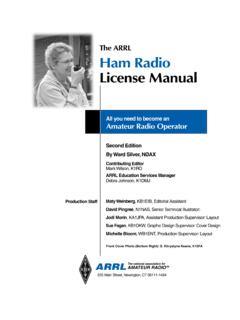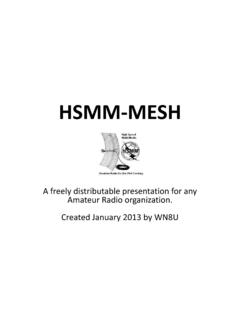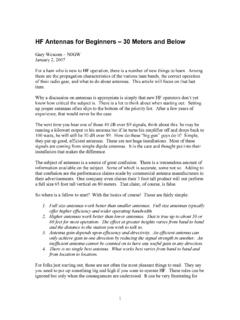Transcription of Discover the Magic Of HF Radio - N4LCD
1 Discover the Magic Of HF Radio By Norm Fusaro, W3IZ HF is FUN With a 100 watt transceiver and a simple wire antenna you can start to communicate and make friends with other hams all over the country or the world. HF id different than FM repeaters. No machine or infrastructure is used. Allows communication beyond line of sight. Contacts are generally a couple of hundred miles to over several thousand miles. Propagation is strongly effected by solar activity. Several communication modes are available to use. SSB, CW, RTTY, SSTV, Digital, AM When most people hear the term ham Radio they generally think of HF or shortwave and long distance communications. HF stands for HIGH FREQUENCY These are the frequencies from * to 30 MHz or the 160 meter to 10 meter bands. HF is also known as shortwave. *160m is actually a Mid Frequency (MF) band but it is included in the Amateur HF bands for ease of discussion.
2 The sun charges particles (ions) in the upper atmosphere. Radio waves change direction when they enter the ionosphere. The Layers of the Ionosphere NVIS - Radio Waves that take off at very high angles are reflected straight back to Earth. The gray line or terminator is a transition region between daylight and darkness. One side of the Earth is coming into sunrise, and the other is just past sunset. Building a Station There are basically two main components involved: 1. A 100 watt Transceiver and 2. An antenna system. The antenna system consist of the radiator, feedline and matching network. Transceivers What makes a good Radio ? Scanning, memories and other bells & whistles are not the important features that make a good HF rig. The receiver s ability to hear weak signals and separate the incoming signals are what makes a good HF rig. The numbers to look at when selecting a transceiver are: 1.
3 Sensitivity (ability to hear signals) and 2. selectivity (ability to distinguish signals) Remember, you can t work them if you can t hear them. Physical Safety NEVER attempt to erect antennas near powerlines. You will be killed. Antennas An antenna system consists of: 1. The antenna or radiator 2. The feedline 3. The matching network or tuner SWR A good SWR is not an indicator of an effective antenna system. Think of a dummy load; it has a good SWR but it is not an effective antenna. The dipole The dipole is the simplest antenna that any amateur can use on HF. Whether fed with coax or open wire, dipoles are cheap and easy to build and install. A dipole can be made for a single band. The total length of the antenna can be calculated by using the formula: 468 freq (MHz) = length in feet Each side, or leg, of the dipole is going to be one half of the total length. Fed with 50 or 75 ohm coax, this antenna will be resonant on a single band that it was cut for.
4 A dipole fed with balanced line (twin lead) and a matching network can be used on multiple bands. 468f (MHz)FeedlineThe DipoleRadiator, Feedline and matching networkmatching network It is not necessary to install dipoles in a horizontal straight line. Inverted VEE _____ _____ Sloping Dipole or Sloper Beams The tri-band Yagi or beam antenna is popular among a lot of HF operators. A modest 3 element model at heights as low as 40 ft can greatly improve your signal. Many hams have earned their DXCC award using a small tri-band beam and 100 watts of power. Three Element Tri-band Yagi Physical Safety NEVER attempt to erect antennas near powerlines. You will be killed. Vertical Antennas It is recommended that you read about vertical antennas in the ARRL Antenna Book before installing one. Many hams new to HF can become disappointed by vertical antennas because they don t understand how they work or listen to myths about them.
5 Once you read and understand about vertical antennas you will find that they are excellent low angle radiators and are great for DXing. A lot of big gun stations have verticals in their arsenal of antennas. Vertical antennas are excellent low angle radiators. Ground mounted verticals require an extensive radial system. Elevated mono-band verticals only require 4 radials to be effective. Physical Safety NEVER attempt to erect antennas near powerlines. You will be killed. Matching Networks The terms antenna tuner, match box, Transmatch and antenna coupler, are all synonyms for a matching network. A matching network is a combination of inductance and capacitance used to cancel out unwanted reactance to better couple the transmitter power to the antenna. The matching network provides an efficient transfer of power from the transceiver to the antenna. The use of a matching network to achieve low SWR does not make a poor antenna radiate better.
6 L Network Pi Network T Network Keeping a Log Book (From the ARRL Handbook) At one time, keeping a log of your contacts was an FCC requirement. The FCC has dropped this equirement in recent years, but many amateurs, both new and old, still keep logs. Why Keep a Log? If keeping a log is optional, why do it? Some of the more important reasons for keeping a log include: Legal protection If you can show a complete log of your activity, it can help you deal with interference complaints. Good recordkeeping can help you protect yourself if you are ever accused of intentional interference, or have a problem with unauthorized use of your call sign. Awards tracking A log helps you keep track of contacts required for DXCC, WAS, or other awards. Keeping a log lets you quickly see how well you are progressing toward your goal.
7 An operating diary A log book is a good place for recording general information about your station. You may be able to tell just how well that new antenna is working compared to the old one by comparing recent QSOs with older contacts. The log book is also a logical place to record new acquisitions (complete with serial numbers in case your gear is ever stolen). You can also record other events, such as the names and calls of visiting operators, license upgrades, or contests, in your log. Paper and Computer Logs Many hams, even those with computers, choose to keep their logs on paper. Paper logs still offer several advantages (such as flexibility) and do not require power. Paper logs also survive hard-drive crashes! Preprinted log sheets are available, or you can create your own. Computers with word processing and publishing software let you create customized log sheets in no time.
8 On the other hand, computer logs offer many advantages to the serious contester or DXer. For example, the computer can search a log and instantly tell you whether you need a particular station for DXCC. Contesters use computer logs in place of dupe sheets to weed out duplicate contacts before they happen, saving valuable time. Computer logs can also tell you at a glance how far along you are toward certain awards. Computer logging programs are available from commercial vendors. Some programs may be available as shareware (you can download it from a website and pay for the program if you like the way it works). If you can program your computer, you can also create your own custom logging program, and then give it to your friends or even sell it! QSLing (From the ARRL Handbook) A QSL card (or just QSL ) is an Amateur Radio tradition. QSL cards are nearly as old as Amateur Radio itself, and the practice has spread so that short-wave listeners (SWLs) can get cards from shortwave and AM broadcast stations.
9 Most amateurs have printed QSL cards. QSL card printers usually have several standard layouts from which to choose. Some offer customized designs at extra cost. If you are just starting out, or anticipate changing your call sign (just think, you could get a call like KC4 WZK ), you may want to purchase a pack of generic QSL cards available from many ham stores and mail-order outlets. Filling Out Your Cards QSL cards must have certain information for them to be usable for award qualification. At a minimum, the card must have: Your call sign, street address, city, state or province and country. This information should be preprinted on one side of your QSL card. The call of the station worked. The date and time (in UTC) of the contact. The signal report. The band and mode used for the contact. Awards for VHF and UHF operations may also require the grid locator (or grid square ) in which your station is located.
10 Current practice is to include your 6-digit grid square on your QSL card even if you have no plans to operate VHF and UHF, since some HF competitions and awards require your grid square designator. Many hams provide additional information on their QSL cards such as the equipment and antennas used during the contact, power levels, former calls and friendly comments. Sending and Receiving Domestic QSLs Although most QSL cards can be sent as post cards within the United States, usually saving some postage costs, post card style QSL cards often arrive with multiple cancellations and other unintended markings that can obscure or obliterate the printed and written information. It is best to send all QSL cards in a protective envelope. Back when postage was cheap, you could send out 100 post cards for a few dollars and domestic stations would send QSLs as a matter of course.










